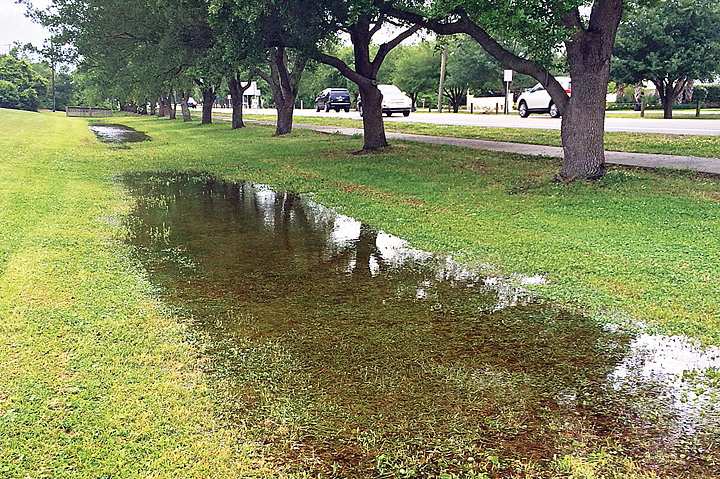Educates citizens, civil engineers about benefits of stormwater management
Through a creative combination of rain barrels, retrofits, rain gardens, pervious surfaces and infiltration chambers, the North Carolina Coastal Federation is working to keep contaminated stormwater from draining into coastal waterways.
Full results of a study to determine the effectiveness of the projects, which were completed in late summer 2014, won’t be available until the end of June, but early results are dramatic: a retrofitted outfall pipe near the south end of Wrightsville Beach has reduced the discharge of fecal coliform bacteria that previously flowed into Banks Channel from that pipe by 99 percent.
The federation’s headquarters on Salisbury Street is the town’s epicenter for stormwater best management practices (BMPs), with at least six stormwater reduction projects located in the direct vicinity of its office. Now that the federation is getting proof of the BMPs’ benefits, southeast regional manager Tracy Skrabal said it can begin encouraging other individuals and communities to install similar projects.
“This is the beginning of the big effort to push this technology out into the world,” Skrabal said, “and Wrightsville Beach is going to be at the forefront of these innovative techniques.”
Skrabal said the federation would use several methods to begin educating the public about the BMPs.
She presented plans to the board of aldermen May 7 for signage to mark several of the projects around town. Many of them are located in public places, but because their characteristics are so subtle most people walk past them without even noticing.
She said the signs themselves would also be unobtrusive. A simple plaque with a brief explanation will mark pervious pavement currently being installed in 40-foot by 40-foot square around both of the storm drains in Wrightsville Beach Park’s main lot.
The chemical makeup of the concrete allows water to seep through, Skrabal explained, so almost no stormwater will reach the drain and dump into Kenan Creek.
The federation would also like to install a low, angled sign near the BMPs along the John Nesbitt Loop. A retrofit on the north side of Causeway Drive diverts water onto the flag football field, helping irrigate the grass. A swale and a rain garden near the federation’s headquarters catch runoff from Salisbury Street.
In an email, the University of North Carolina Wilmington’s Dr. Mike Mallen, who is comparing recent bacteria levels in the waterway to baseline measures, stated the BMPs have reduced the discharge of fecal coliform bacteria and Enterococcus bacteria leaving the outfall pipe by 50 percent and 26 percent, respectively.
Some of the BMPs, like the swale alongside Salisbury Street, are designed to hold water and block it from entering the outfall pipe up until a certain point, when the swale is in danger of overflowing. But even as Tropical Storm Ana dumped more than four inches of rain on Wrightsville Beach over four days, Skrabal said no stormwater entered the drain.
While the signage around town won’t be installed until late summer, Skrabal said, the federation is able to move ahead with marking each of the BMPs on its own premises with signs this week. Those projects include several relatively inexpensive and simple techniques, like a plastic filtration chamber an individual would simply purchase and bury in a hole under their drainpipe.
In addition to educating citizens, Skrabal said the Coastal Federation is giving a BMP tour to 25 members of the American Society of Civil Engineers and representatives of the North Carolina Department of Transportation May 28. She said they’ve shown interest in implementing some of the techniques themselves.
And more BMPs for Wrightsville Beach are also on the horizon, Skrabal added. The Coastal Federation was able to install the existing BMPs with a grant from the National Estuarine Research Reserve, so it is currently seeking more grants.
She said the federation would like to retrofit three or four more outfall pipes that pour water off Waynick Boulevard into Banks Channel, where so many people swim and play. Some of the outfall pipes are on private land, but she said a few of them are on town property and owners of the Blockade Runner Beach Resort have indicated they would want their outfall pipe retrofitted. Retrofitting the pipes would require a grant, she said, because each project is roughly $40,000.
Cost is always a concern for both individuals and municipalities considering installing BMPs, Skrabal admitted, because it means making choices like purchasing a $100 rain barrel or opting for more expensive, pervious concrete.
“But we think that’s very much offset by the cost of protecting our waters,” she said.
email [email protected]




